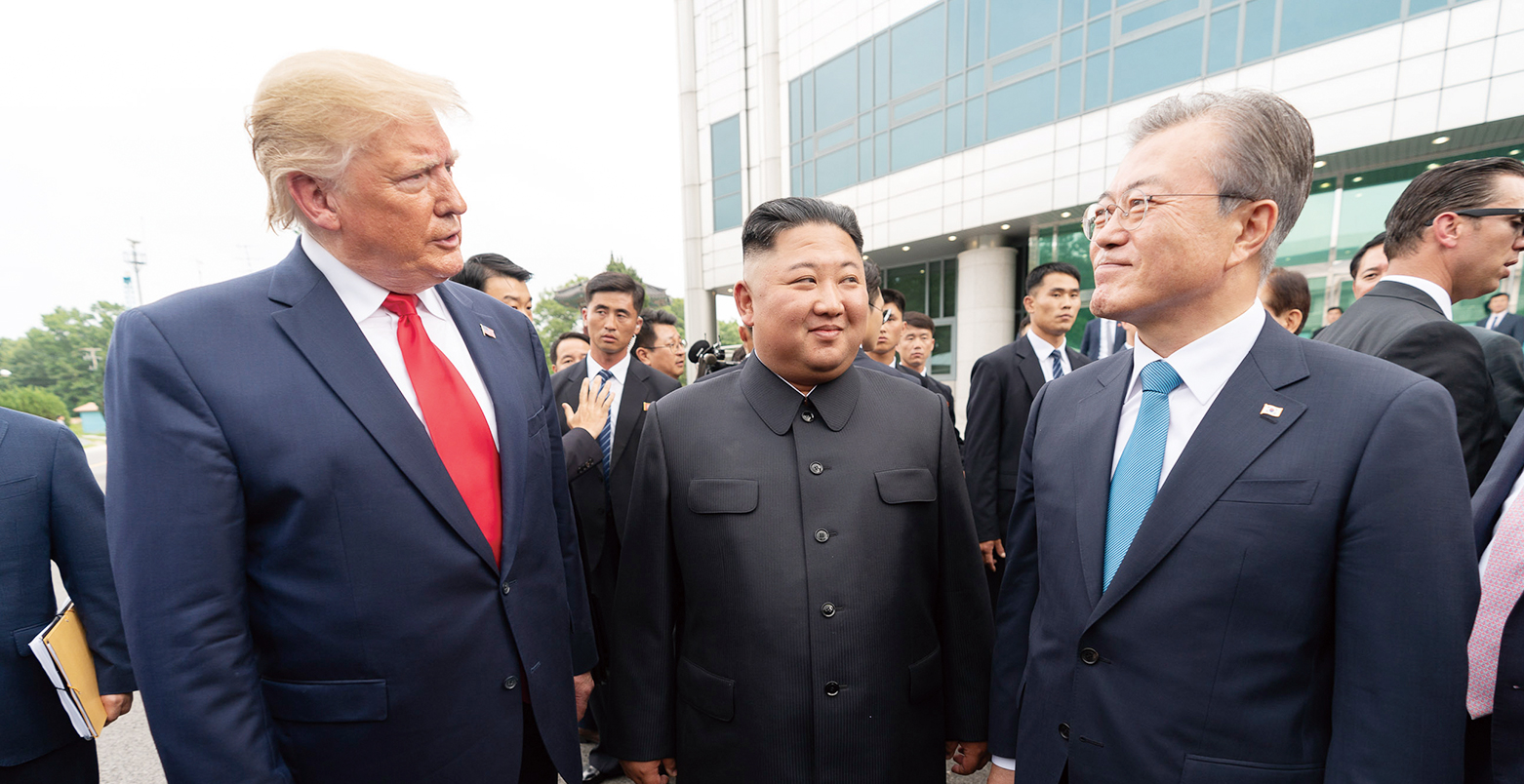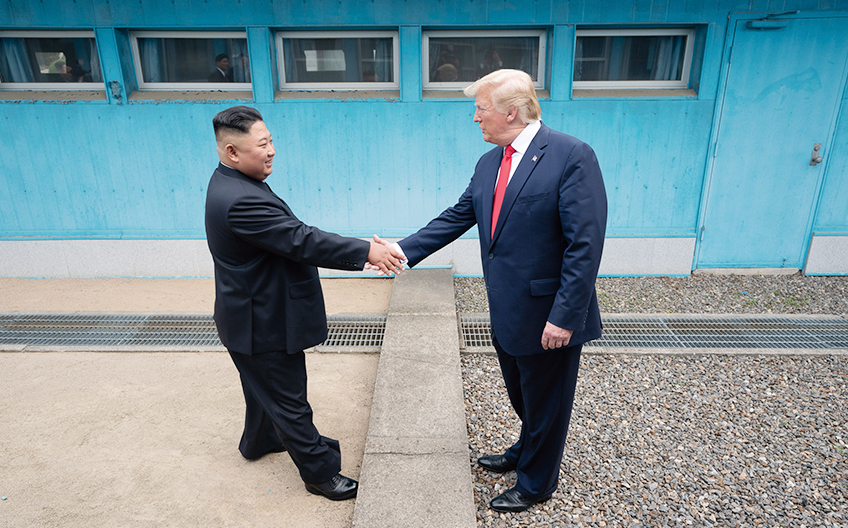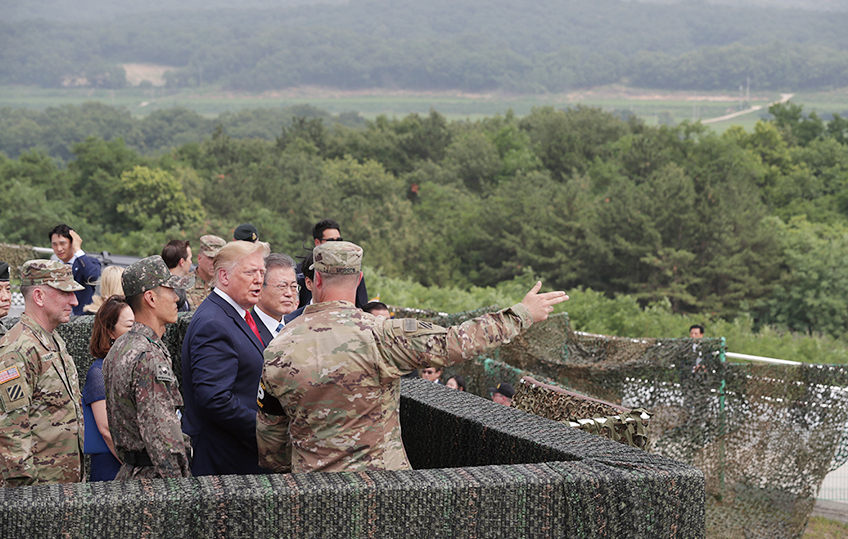
Contents










Current Korea · Written by Sohn Ji-ae Photo courtesy of White House
Low-key but
Instrumental Role
President Moon Jae-in has remained low-key in mediating dialogue between the U.S. and
North Korea, but his role as a mediator and facilitator in such talks, however, has proven decisive
in making the negotiations possible. The historic DMZ meeting on June 30 between the
leaders of the U.S. and the North on the inter-Korean border further attests to
President Moon’s behind-the-scenes but beneficial diplomacy.

President Moon Jae-in (right) on June 30 gathers with U.S. President Donald Trump (left) and North Korean leader Kim Jong Un (center) in front of Freedom House in Panmunjeom.
When U.S. President Donald Trump on June 30 crossed the curb separating the two Koreas at the Demilitarized Zone (DMZ) and stepped into North Korea to shake hands with the North’s leader Kim Jong Un, President Moon Jae-in stayed inside Freedom House on the southern side of the United Nations (U.N.) truce village of Panmunjeom.
After the historic encounter, President Moon welcomed the two leaders at Freedom House and led them into a room so that they could hold one-on-one talks, and he went to a separate room until they were finished.
On the surface, the impromptu border meeting was the result of both Trump and Kim’s determination to jumpstart denuclearization talks that had stalled since their Feb. 27-28 summit in Hanoi, Vietnam, ended with no agreement. What is undeniable, however, is that President Moon’s behind-the-scenes influence helped make the talks happen at the heavily fortified DMZ.
Dovish Approach
President Moon remained low key in the lead-up to the DMZ talks, a position he has maintained throughout the inter-Korean peace process.
His consistent pursuit of a dovish approach toward Pyeongyang was crucial in making the surprise DMZ meeting possible. The president has always sought peace and dialogue despite uncertainty over what direction the negotiating process could take under this strategy. His approach has proven instrumental in fostering a reciprocal mood in U.S.-North Korea dialogue, as well as in solidifying the trust of both Trump and Kim in President Moon. Furthermore, this has paved the way for the U.S. and North Korean leaders to hold face-to-face talks first in Singapore, then in Hanoi and finally at the inter-Korean border.
Rather than try to claim individual recognition for his efforts, President Moon has always credited Trump for the success of all three U.S.-North Korea summits. Following the DMZ meeting, President Moon said, “Thanks to (Trump’s) bold offer (via tweet) of a meeting with Chairman Kim, this historic meeting has taken place. I’d like to pay tribute to the creative and bold approach Trump has demonstrated.”

U.S. President Donald Trump and North Korean leader Kim Jong Un on June 30 shake hands over the Military Demarcation Line in Panmunjeom.
Growing Mediatory Role
President Moon’s mediatory role is expected to grow further as the U.S. and North Korea enter working-level negotiations on another high-level bilateral summit. Both sides have agreed to each set up a negotiating team to advance their nuclear talks, and Trump has also invited Kim to Washington.
In this process, President Moon’s mediatory role appears crucial. Trump also credited President Moon’s role for the progress witnessed so far, adding that the South Korean leader should be closely involved in U.S-North Korea negotiations.
President Moon said that though the U.S. and the North have no agreements on paper, the actions their leaders showed at the border signified “a declaration to end hostile relations and start an era of peace.”
Just a few years ago, the notion of the American president stepping into the North is something the world would have never expected, not to mention that both Trump and Kim wore suits instead of body armor or military uniforms. The DMZ encounter thus gave big hope for peace to the Korean people as well as the world.
Expectations are now sky-high for a breakthrough in subsequent dialogue, though the prospects of Washington and Pyeongyang narrowing their fundamental differences in negotiations remain unclear. What is clear, however, is that without President Moon’s quiet but powerful mediatory role, progress in the peace process on the peninsula would neither have been nor be possible.

Presidents Moon and Trump visit an observation post in the DMZ wearing suits instead of military uniforms and body armor.
Other Articles















